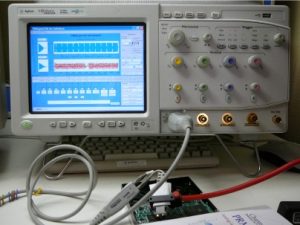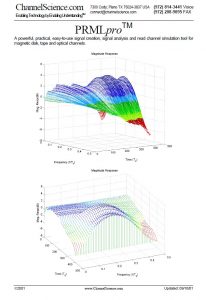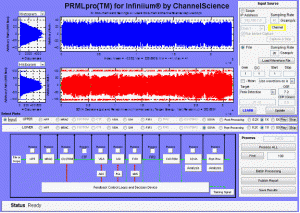PRMLpro™
PRML Read Channel Development and PRMLpro™
Partial response maximum likelihood sequence detection is the foundation of modern noise predictive, 2D, iterative detectors for mass storage. We are proud that ChannelScience's expertise, tools, and training were used throughout the industry to accelerate the adoption of this important technological change!
 Our flagship product for the adoption of PRML techniques, PRMLpro™, is no longer being updated.
Our flagship product for the adoption of PRML techniques, PRMLpro™, is no longer being updated.
However, for those of you who used it and are nostalgic, and for those of you who are just curious, this page shares some of the PRMLpro™ technical and marketing documents.
PRMLpro™ is a MATLAB® graphical user interface (GUI) to a sophisticated PRML read channel model. The model is written in MATLAB® and compiled to executable C code. MATLAB® is not required to run PRMLpro™.
Three versions of PRMLpro™ are available: PRMLpro™ Student Edition, PRMLpro™ StandAlone and PRMLpro™ for MATLAB®. Each version is licensed for one-year, after such time the software deactivates itself. Software maintenance contracts are available to ensure uninterrupted use of PRMLpro™.
All versions of PRMLpro™ include individual screens for binary data sector creation (including scrambler, RLL endec and precoder functions); waveform creation (supports oscilloscope files, sync pulses and Lorentzian/Gaussian; includes media noise model); continuous-time filtering, discrete-time filtering (with LMS adaptation of the FIR), adding noise and distortion (white and colored noises, thermal asperities and disk defects) and detailed analysis of the Viterbi detection algorithm.
Furthermore, the latest versions of PRMLpro™ include two new screens. One screen is an integrated model
of the read channel front-end. This includes AC coupling, MR asymmetry compensation, continuous-time filtering, adaptive discrete-time filtering, automatic gain control (AGC) and PR4 phase-locked loop (PLL). Both data- and decision-directed modes are supported. This screen also provides for adding noise, offset and distortion to various points in the front-end. For example, one could analyze the reaction of the PLL to a 5% phase error introduced at the Nth sample. The second new screen simulates the Viterbi detector and sync detector and can also call the front-end processing screen. This channel simulation screen also provides extensive analysis of the detected data, including histograms and correlations.
The student version is provided to every student of the PRML Lab course, written by ChannelScience.com and presented through KnowledgeTek, Inc. The student edition is also ideal for university courses in communications, filtering, Viterbi detection and data storage. It has most of the functionality of PRMLpro™ StandAlone, but has limits on waveform sizes and advanced features such as fractionally spaced equalizers, tap weight quantization, post-processors, servo pattern creation, etc.
 PRMLpro™ within MATLAB® combines the full functionality of PRMLpro™ StandAlone with automatic data exchange with MATLAB®. You must have your o
PRMLpro™ within MATLAB® combines the full functionality of PRMLpro™ StandAlone with automatic data exchange with MATLAB®. You must have your o
wn copy of MATLAB® to run this version of PRMLpro™. All important variables are assigned to the MATLAB® workspace so you can easily include PRMLpro™ output with your existing MATLAB® functions. You can also customize every PRMLpro™ graph and even add your own variables to the graphs. An especially useful feature is that the PRMLpro™ for MATLAB® edit boxes support embedded MATLAB® commands, such as conv and matrix indexing.
Click to download the overview of PRMLpro™ for a closer look at each screen.
Please contact ChannelScience if you have questions about PRMLpro™.
Additional PRMLpro™ Resources
Below are some additional related papers and articles that may be of interest.
Archived edition of on-line Data Storage Magazine article (.pdf) with Jay Alexander of Agilent: Deep Memory Scopes Speed BER Analysis (January 2002)
Japanese translation of on-line Data Storage Magazine article (.pdf) with Jay Alexander of Agilent:Deep Memory Scopes Speed BER Analysis (January 2002)
Cover story from Data Storage Magazine (.pdf): LMS Filter Adaptation in PRML Channels (Data Storage Magazine, August 2000, pp. 15-22)
Manuals/User Guides
Please contact ChannelScience to request a PDF of an archived version of the 300+ page PRMLpro™ User Manual.